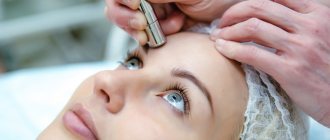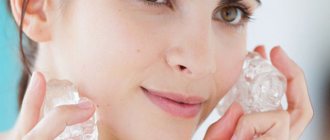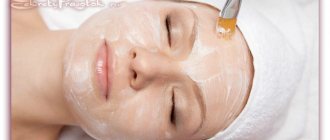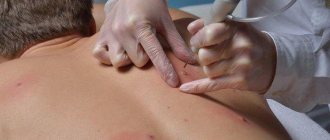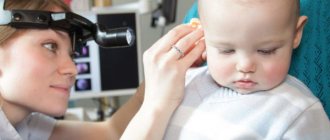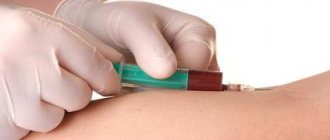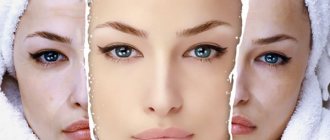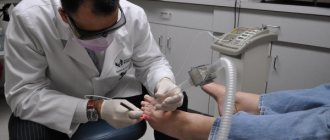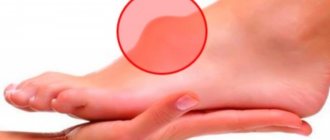There are many cosmetic procedures with which any girl can get rid of unwanted hair on her body - both in the salon and at home. One of them is photoepilation. The technique is one of the total methods of hair removal, allowing you to quickly achieve ideal smoothness of the skin. In this article we will take a closer look at what photoepilation is, the pros and cons of the technique.
How the method came about
The creation of photoepilation was based on observations of peoples living on the equator, where high intensity solar radiation remains throughout the year. There is almost no hair on the body of people living in these regions.
This effect was borrowed from photoepilation, which uses light energy to get rid of excess hair and improve the overall condition of the skin. Compared to ordinary solar radiation, the rays used during the procedure have an important advantage: their spectrum is completely absent of ultraviolet.
Therefore, photoepilation has a fairly high degree of safety. The use of the method began in the 90s of the last century, but it began to gain popularity only 10 years ago.
Photoepilation appeared in the 90s
Where are photons used?
Pulsed light wave hair removal is more often used to eliminate hair anywhere on the body; there is no location limitation. The entire procedure is quick and completely painless, leaving the skin cleansed and velvety.
There are indications and contraindications for photoepilation for the procedure. The disadvantages are strictly individual, only a specialist will consider them. After a solarium or the beach - definitely not.
Types of procedures
Today there are two main methods of photoepilation:
- Laser photoepilation is carried out using an alexandrite, diode, ruby or YAG laser as light sources.
- Broadband photoepilation – based on the IPL principle.
There are no significant differences between the two methods. In both cases, light energy is used, which operates according to a single mechanism. Essentially, the IPL system is a cheaper alternative to laser.
Other differences:
- Laser photoepilation can be performed on tanned, dark skin, but for the use of IPL systems, the presence of a tan and dark skin color are a contraindication.
- The laser beam has a small divergence angle, due to which a large amount of energy penetrates down to the deep layers of the skin.
- A laser generates light of one wavelength, so one type of laser is used to solve one type of problem. With the help of IPL systems, radiation of a wide spectrum is obtained, making it possible to solve a wider range of problems.
- Laser photoepilation affects small areas of the skin, while IPL photoepilation allows you to treat large areas of the skin.
- Compared to laser, broadband photoepilation is less painful.
Generally speaking, the correct selection of settings brings both methods closer in effectiveness.
Reviews about photoepilation at home: before and after photos
No matter how complicated photoepilation may seem, it can be done at home, although previously it was an exclusively salon procedure.
Now you can buy mini photoepilators, which are very compact and convenient for home use.
But it’s not just the size that distinguishes a home device from a salon device. The difference is that a professional device can be set to the required power level. It is set by a specialist, based on the hair structure and skin characteristics. But mini-photoepilators are set to low power without the possibility of adjustment. This is more of a plus than a disadvantage of the device, because it will protect the novice user from burns and other side effects that occur while using the photoepilator.
But you can still select a mode on the device that is suitable for a specific area of skin. This is especially necessary for sensitive skin areas: face, bikini, armpits. An incorrectly set mode will cause pain during hair removal.
Home photoepilators from modern manufacturers are becoming more and more similar to professional ones (based on the principle of the device). In addition, they are cheaper than a hair removal session in a salon.
How it works
After absorbing a sufficient amount of light energy, the tissues are heated to a temperature that leads to their destruction. This process is called thermolysis. During photoepilation, thermolysis occurs under the influence of light energy, which is why it is called photothermolysis.
Fabrics with different colors absorb energy at different rates. The darker the hair, the more melanin it contains. Therefore, to carry out the procedure, light sources are used that emit waves of such a length that melanin absorbs in greater quantities and other pigments contained in the skin in smaller quantities. This selective action is called selective thermolysis.
During photoepilation, thermolysis occurs
During this process, the hair is heated to 75-80 degrees, as a result, all cells of the hair follicle and papilla die, and hair growth stops. In some cases, it is possible not to destroy, but to significantly damage the follicle, which leads to its atrophy, disruption of the natural hair growth cycle, and a decrease in its thickness and degree of pigmentation.
Advantages
Compared to conventional laser hair removal, photoepilation has a number of advantages, although the question of which is better and which method should be preferred is decided in each case individually, depending on the problems being solved.
- Photoepilation is an almost universal method. With its help, you can remove hair of different colors (except gray and very light), with different structures in people of all phototypes and of any age.
- Photoepilation produces a simultaneous effect on a fairly large area of skin (up to 5 sq. cm)
- Already as a result of 1-2 sessions, the hair becomes thinner and sparser, its structure is disrupted, however, to obtain a lasting effect, 3-7 procedures are required, carried out at intervals of several weeks to 1.5 months.
- Photoepilation is one of the safest cosmetic procedures. The light used is as close as possible in structure to solar light, but lacks the harmful ultraviolet component.
- Another plus is the high speed of hair removal. Depending on the size of the area being treated, the session takes 5-30 minutes.
- There is almost no pain during the procedure.
- The risk of subsequent infection is minimal, since the integrity of the skin is not compromised (thanks to the non-contact method of exposure).
- The process of permanent hair destruction is irreversible.
- When the procedure is carried out correctly, complications and side effects are minimized.
- Simultaneously with hair removal, skin rejuvenation is achieved, since collagen is produced during the procedure, the skin is restored and smoothed.
- Eliminates the appearance of ingrown hairs.
- The photoepilation technique is suitable for removing hair from any part of the body: face, chest, back, legs, arms, armpits, bikini area.
What is better to choose: photoepilation or laser hair removal?
Not everyone can understand what the difference is between these two types of hair removal? The main difference is the type of light used that affects the hair. Laser hair removal uses light that is concentrated into a single beam, while photo hair removal uses light that is distributed more widely. Its intensity in this case is slightly lower, but photowaves are able to cover a larger processing area.
Laser hair removal has two undeniable advantages over photoepilation. Firstly, the cost of laser hair removal is twice as much as photoepilation. Secondly, the number of procedures for laser hair removal is significantly less. But on the other hand, the duration of one photoepilation procedure is much shorter than laser hair removal. In addition, each type of hair requires a separate type of device for laser removal. They are often made for either dark hair or blonde and red hair. For beauty salons, it is easier to purchase one high-quality photoepilation device than to buy several for laser hair removal.
Clients often want to spend a minimum of their time, but at the same time get a good and lasting result. This is exactly the effect that can be achieved using photoepilation. Photoepilation devices are capable of treating a larger area, unlike laser hair removal. On average, the width of the action spectrum of a photoepilation device can vary from 3 to 13 sq.cm.
Indications
Photoepilation is mainly used to solve aesthetic problems: removing unwanted hair. There are additional indications for the procedure:
Photoepilation is indicated for age spots
- increased skin oiliness;
- dark spots;
- the severity of the vascular network;
- the appearance of wrinkles.
Photoepilation is performed not only for women, but also for men. For the stronger sex, this is an excellent opportunity to get rid of such unpleasant phenomena as irritation after shaving and aesthetic discomfort arising from the presence of excess hair in some areas of the body. Since testosterone is constantly produced in the male body, the procedure must be repeated 2 or 3 times during the year.
Photoepilation is also carried out for medical reasons. These include:
- hemangiomas;
- telangiectasia;
- hirsutism (male pattern hair growth in women);
- hypertrichosis (intensive hair growth);
- decreased skin turgor;
- in men: increased skin sensitivity, leading to severe irritation of the skin of the face and neck after shaving.
What devices are the most effective?
The English device IPulse is widely used for this procedure. It has a wider “spraying” of photons – up to ten square centimeters, while other devices have an area three times smaller. IPulse saves beauty patients time. Additionally, something like a micro-conditioner is installed on it, making the procedure softer.
- Airtouch coloring - an overview of all the features, pros and cons
Darsonval for the face - reviews, photos and videos of procedures, indications and contraindications. Secrets of facial skin care at home
SMAS lifting - an overview of the facelift procedure
Contraindications
Contraindications to photoepilation can be divided into general, local and relative. General absolutes include:
- allergic skin reactions;
- dermatological diseases with acute and chronic course: psoriasis, eczema, collagenosis, cystic dermatoses, ichthyosis, lichen planus;
- varicose veins;
- diabetes mellitus in the stage of decompensation;
- cardiac ischemia;
- hypertonic disease;
- infectious diseases;
- feverish conditions;
- tendency to form keloid scars;
- herpes (acute forms);
- the presence of malignant neoplasms on the skin;
- hemophilia, other diseases associated with blood clotting disorders;
- photodermatosis, leading to increased sensitivity of the skin to sunlight;
- period of treatment with photosensitizing drugs (fluoroquinolones, tetracyclines, retinoids, hormonal contraceptives);
- epilepsy;
- mental pathologies;
In case of hyperthyroidism and polycystic ovary syndrome, normalization of hormonal levels with the help of drug therapy is necessary before the procedure.
Local contraindications include:
- infectious inflammatory skin diseases;
- manifestations of varicose veins;
- Permanent makeup;
- tattoos;
- applying self-tanning or fresh tanning;
- presence of “golden threads” in the skin;
- external use of products containing photosensitizing substances (for example, essential oils);
- parasitic diseases;
- pigmented nevi, other neoplasms.
The procedure is not indicated during pregnancy and breastfeeding. These are relative contraindications. The fact is that during these periods there is a significant change in hormonal levels, so the effectiveness of photoepilation decreases.
In addition, the effect of pulsed light on the fetus has not been sufficiently studied, which is another reason for refusing this method of hair removal when carrying a child. !Exposure to pigmented nevi (both flat and raised above the skin) is very dangerous.
The intense radiation used during photoepilation can cause burns and even malignant degeneration of the formation into melanoma. Any method of epilation of hair growing from nevi is prohibited: it is better to simply cut them off.
If necessary, the mole can be removed. If the hair continues to grow after this, it can be epilated (via electrolysis).
Who is it shown to?
Despite the apparent ease of the procedure, before carrying out it, you must consult a dermatologist who will determine its possible effectiveness.
The only absolute indication would be hair removal, the excess growth of which is not associated with hormonal imbalances.
Hair removal will not cause harm, but unnecessary hair may appear as early as 5 months after the last session. This happens more often in women with elevated levels of male hormones.
Photoepilation devices
The equipment used in clinics and salons differs in such indicators as the number of programs, power, flash speed, filtration technology, and lamp operating life.
For photoepilation, broadband light sources are often used. This is special equipment that produces powerful pulsed light with a wavelength in the range of 500-1200 nm. The light of krypton lamps used includes a wide range of light waves, including ultraviolet, which is unsafe for humans.
To prevent harmful radiation from entering the skin, special filters made from high-tech materials or special glass are used.
- Skin Station Mistral is a multifunctional light-thermal system that can be used to provide a full range of services from hair removal to skin rejuvenation and treatment of dermatological diseases.
- Ellipse Light - a high degree of device safety is achieved by the Dual Mode Filtering system.
- Record 618 – can be used for any skin type and any hair structure.
- Classic 512 - belongs to the class of professional equipment used for photoepilation and photorejuvenation of the skin.
- Quantum HR/SR, Quantum IPL - using this equipment you can generate a wide range of waves, change the flash duration, the number of pulses, and the intervals between flashes.
- Apollo V+ is equipped with a built-in computer, with which you can (depending on the characteristics of the client’s skin and hair) configure the necessary parameters of the system: pulse duration, energy, number of pulses, intervals between them.
In addition to professional devices for photoepilation, there are devices for carrying out the procedure at home: E-Flash, HPLight, E-one Clinic R, E-ONE Evolution, Remington IPL6000 i-Light Pro, etc.
Preparatory stage
No special preparation is required for photoepilation. The rule to follow is: the hair length should be approximately 1-1.5 mm. If the hair is longer, it is shaved first. Specific shaving times vary depending on the area being treated:
Do not sunbathe before photoepilation
- Armpits, bikini area - 1-2 days before the procedure;
- Hips, legs - 3 days in advance (if the hair has already been shaved before).
You cannot shave hair on the following areas of the body: arms, chest, abdomen, back, buttocks, areola of the mammary glands, face, neck. Hair removal from these areas is carried out by a doctor immediately before photoepilation.
Before the session begins, cosmetics, massage and aromatic oils must be removed from the surface of the skin.
!2-3 weeks before the procedure, you must avoid tanning, stop visiting solariums and limit your time in the sun.
Execution method
During the procedure, both the master and the client wear special protective glasses. To prevent pain and burns, a special transparent cooling gel is applied to the treated area. If the skin is hypersensitive, a cream with anesthetic properties is applied to it approximately 1.5 hours before the start of the procedure. As a rule, the product contains lidocaine.
The device is adjusted before each procedure, taking into account all the features of the skin, the presence of certain problems, and the properties of the hair.
The essence of the procedure is that the doctor moves the tip of the parting over the skin, and light flashes occur at certain intervals. They are the ones who affect the hair follicles, leading to their destruction.
During the session, the specialist asks the client about his feelings. If severe pain occurs, the intensity of radiation is reduced, which helps avoid burns.
The final stage is treating the skin with a softening cream or aerosol. For sensitive skin, you can use Panthenol aerosol. This product is designed specifically to accelerate the regeneration of damaged skin and help avoid burns.
!Many clients are interested in whether exposure to light waves is harmful. As a rule, modern salons and medical centers use the latest laser equipment for photoepilation, guaranteeing a high degree of safety and minimizing side effects.
A lot depends on the professionalism of the cosmetologist. You should only contact a person with a special medical education who has completed courses in working with laser equipment.
What types of photoepilation exist now?
Now beauty salons, one after another, are beginning to offer various procedures aimed at removing hair from any part of the body. As for photoepilation, there are three classic types. Each type has a different spectrum of action.
The photo shows how photoepilation of the armpits takes place
IPL hair removal is one of the most common methods of influencing the hair follicle. It consists of using a series of flashes that have high intensity. IPL hair removal is used only to combat dark body hair. This type of light is not able to affect hair that has red or light pigment. Also, this type of hair removal does not combat gray hair. But on the other hand, IPL hair removal can be used on any part of the body. Also, this type of hair removal is characterized by setting the device for each patient. Modern equipment makes it possible to adjust a certain frequency of waves, their depth and intensity. Therefore, this type of photoepilation can be called one of the most universal.
Elos hair removal is another classic type of photo hair removal. The action of this device is aimed only at light-colored hair. Elos hair removal is characterized by a uniform distribution of temperature along the hair. This occurs through the use of intense light. This type of photoepilation can be called one of the safest, since the skin is completely protected from overheating. In addition, elos hair removal is not capable of causing irritation or inflammation in the treated area of the skin. But it is worth noting that this type of photoepilation should not be used by those people who naturally have dark skin color.
The photo shows how facial photoepilation is done
LHE hair removal is photoepilation, which is performed only on clean and dry skin. It is worth noting that, unlike other methods, LHE hair removal does not require the use of cooling gels during the procedure. Because of this nuance, LHE photoepilation is a little painful. It is often used to combat unwanted light and gray hair. This type of photoepilation differs from others in that the devices cover a large area on the treated surface. In one flash it can affect up to 11 sq/cm of skin. The time required for LHE hair removal is significantly minimized.
After the procedure
In the initial period after photoepilation (for several days), it is not recommended to use cosmetics. You should avoid visiting the swimming pool, bathhouse, or sauna. For about 2-3 weeks you should not sunbathe, use self-tanner, or be in direct sunlight. You are allowed to take a cool shower.
After the procedure, you can take a cool shower
Result and recommended number of sessions
After just one irradiation, hair in the growing stage disappears forever. Their loss on the treated area continues for several weeks after photoepilation.
Exactly how many sessions are needed depends on the area being treated, skin color, hair structure characteristics, stage of hair growth and is determined in each case separately. Hairs that have not yet entered the active growth stage are not irradiated.
Therefore, sometimes a repeated, and in some cases multiple, procedure is required. As a rule, one area is processed 3 to 10 times. The interval between sessions is 20-30 days.
Only after completing the entire course can you objectively evaluate the effect achieved. Today, photoepilation is considered one of the most effective ways to remove unwanted hair. The result obtained lasts for life or for a very long time.
How long can the results last after photoepilation?
Judging by the reviews of satisfied clients, on average, the result of photoepilation can last about 4-5 years. During this time period, hair stops growing altogether. If all photoepilation technology was correctly followed, then a lasting result occurs after 4-8 procedures. Don’t think that after one photoepilation your hair will stop growing forever. This simply cannot happen. By nature, we have both active hairs and “dormant” hairs. It is the “sleeping” ones that begin their activities after the active ones are removed. After 1 procedure, experts claim that only 20-30% of active hair is removed. For a lasting result, up to 10 courses may be needed, because everything depends on the area of treatment and the individual characteristics of the person.
Photo of the photoepilation result
But there are cases when photoepilation does not maintain a lasting effect. This can happen for several reasons at once. Firstly, the wrong equipment was selected or the wrong mode was set. Secondly, the client did not follow the cosmetologist’s instructions correctly before and after photoepilation.
In 2007, American scientists conducted a study in which they wanted to find out how long the result after photoepilation could last. The experiment involved 207 people who were specially selected with the same skin type and color. The indicators of all participants in the experiment were taken into account in the study, since people had unwanted hairs removed from different parts of the body.
Photo of back photoepilation
Most people had two to six treatments, but there were cases where repetitions of up to 10 and 13 were required. For correct calculations, the average was calculated. At the end of the entire course of photoepilation, each of the respondents was surveyed regarding the effectiveness of the procedure performed. As a result, it turned out that 45 participants in the experiment were very satisfied with the durability of the result, 93 respondents limited themselves to a satisfactory rating, and 69 participants were dissatisfied with the result. Scientists have concluded that in order to achieve a full, lasting result, some people need to carry out single procedures after 6 or 12 months. This is the only way to achieve what you want, because not everyone has the same color and hair growth activity.
Possible reasons for ineffectiveness
In some cases, photoepilation does not give the expected result. This may be due to several factors:
- Using insufficiently powerful devices. Clinical trials show that the optimal effect is achieved when the skin is exposed to light pulses of at least 25 J/sq.cm
- Incorrect settings of the device parameters, inconsistency with the characteristics of the client’s skin and hair. A photoepilator must have options for regulating the main parameters that influence the result.
- Incomplete destruction of the hair follicle. This can happen due to insufficient professionalism of the cosmetologist. Inability to use the device or set it up correctly leads to the fact that the rate of hair growth slows down, the thickness is reduced, the life cycle is disrupted, but hair growth does not stop.
Is there an alternative?
The modern cosmetology industry almost daily throws creams and other bio- and chemical preparations onto the hair removal market to cleanse the skin of follicles. Below we present the process of how photoepilation is done.
Photoepilation is gaining popularity. But this attachment has nothing to do with conventional photography. Selfies don't cause excess hair to fall out.
Adverse events
The basis of photoepilation is the burning of hair follicles. Carrying out the procedure using a cooling system eliminates the possibility of burning the skin. The epidermis is also not damaged, since modern devices are equipped with filters to protect against the UV spectrum of the light wave.
However, in some cases, after photoepilation, some side effects may occur: swelling, redness, pain in the treated area. They are stored for a certain period of time. The persistence of such phenomena depends on the intensity of the light flux, the thickness and thickness of the hair, skin color, etc.
If discomfort persists for 2-3 hours, local application of cooling and painkillers, including injections of anesthetics, is recommended. The duration of the rehabilitation period is on average 5-7 days.
Recommendations for skin care after
Several hours after hair removal, symptoms of skin irritation appear , which usually manifest as slight redness or tingling.
This is a normal reaction to light radiation. To reduce discomfort and soothe the skin, use soothing creams based on panthenol .
It is applied to the treated areas in the morning and evening. Cosmetics containing chamomile decoction or aloe juice have a similar effect.
For the first two to three weeks, it is forbidden to use oils and fatty creams. They form an airtight film on the skin that prevents skin regeneration.
You need to be careful with products that contain alcohol or many chemical ingredients.
To care for damaged skin, it is better to use natural cosmetics from hypoallergenic series.
You can find out whether photoepilation is harmful to skin health, how to prepare for the procedure and how it goes from this video:
Possible complications
Folliculitis
The cause of its occurrence can be hyperhidrosis, as well as water procedures (visiting a bathhouse, sauna, swimming pool) in the first days after photoepilation.
Acnemorphic reactions
Most often they appear in young clients with dark skin. As a rule, special treatment for acne-like rashes is not required: they go away on their own within 5-8 days.
Allergies may occur after photoepilation
Burns
The risk of their occurrence especially increases with tanned skin with a high melanin content and when sensitive thin skin is treated with a high-density stream of light energy.
Allergic reactions
These include itching, urticaria, and various forms of dermatitis. The cause of their manifestation may be an allergy to the anesthetics used during the procedure or to sunlight.
Exacerbation of herpes
Perhaps in cases where patients previously experienced symptoms of herpetic infection in the treated area. To prevent this phenomenon, patients are prescribed antiviral drugs a few days before photoepilation.
Deterioration of vision, eye damage
The development of this complication is associated solely with ignoring the requirement to protect the eyes during the session with the help of special glasses, special contact lenses or other means. In most cases, this complication occurs during the procedure in the eyebrow area.
Disturbance of skin pigmentation. It is a consequence of burns and manifests itself in the form of depigmented light spots against the background of dark skin.
Scarring
Their formation is also associated with burns. They often appear in the lower jaw area and on the neck.
Bromhidrosis, hyperhidrosis
Their essence lies in the disruption of sweating in the irradiated area. The occurrence of these complications is associated with damage to the sweat glands during the treatment of hair follicles.
Paradoxical hypertrichosis
Expressed in the form of increased hair growth after photoepilation. Most often it occurs in the face, neck, and also at the border of irradiated and non-irradiated areas. The reason for this phenomenon is often the low density of light flux, the impact of which is insufficient to completely destroy the hair follicle and leads to stimulation of hair growth.
Graying of hair
This consequence of photoepilation is due to the loss of pigment. This phenomenon occurs in extremely rare cases: gray hair begins to grow instead of natural color.
Malignant degeneration of skin cells
This is the most dangerous complication of photoepilation. It occurs due to irradiation of papillomas, pigmented nevi (moles) and other neoplasms on the skin.
FAQ
Many consumers have many questions about the procedure. Below are the most popular ones.
Can I shave my hair after the session?
As you know, hair does not fall out immediately after photoepilation, but it takes on a shrunken appearance, which does not look very aesthetically pleasing. Experts do not prohibit using a razor to remove these hairs. However, it is better to shave them off 2–3 days after the procedure to give the skin a chance to “rest.” In addition, after the dead hair is shaved, you can track the growth rate of new hairs.
Does hair grow after photoepilation?
Hairs do not grow from destroyed follicles. But there are many dormant bulbs in the skin, which awaken over time and give life to new hairs. Therefore, experts set the duration of the effect to 5 years.
How long does the result last?
The effect after photoepilation on the arms, legs and bikini area lasts from 6 months to 5 years, and on the face - 7–8 months. Then the course resumes again.
How often can the procedure be done?
The answer to this question cannot be unambiguous, since much depends on the individual characteristics of the body: hair growth rate, thickness, color, structure, etc. However, repeated procedures can be prescribed no earlier than 2 weeks after the previous photoepilation.
Is it possible to do photoepilation during menstruation?
Women's days are not a contraindication to the procedure. However, we should not forget that during this period the pain threshold is significantly reduced, and painful sensations may occur during photoepilation. It is better to reschedule the session to day 5–6 of the cycle. If a woman tolerates the procedure normally, then there are no restrictions in this case at all, except for epilation of the bikini area.
Is hair removal with a light beam harmful to health?
No. Special filters are installed in professional handpieces or home devices that cut off unnecessary parts of the spectrum. As a result, only those waves that affect the hair, and not the skin, remain. Therefore, there are no health hazards such as radiation exposure.
Photoepilators are equipped with special filters that do not allow the harmful part of the spectrum to pass through, which destroys skin cells.
Photoepilation: does it hurt?
Photoepilation is a painless method of removing hair from the surface of the skin. But, according to customer reviews, painful manifestations may occur when treating sensitive areas. However, with each subsequent session, the pain even in these parts of the body subsides.
What skin color is this method suitable for?
The procedure is most effective on light skin with dark hair. In this case, the light beam will be well absorbed by melanin in the hair shaft, and not in the skin cells. In principle, it can be argued that photoepilation works on all skin phototypes, except brown and dark brown.
How long does it take for hair to fall out after the procedure?
Hair usually leaves the skin within 5–14 days.
What length of hair is needed for photoepilation?
If a salon procedure is performed, the length of hair on the skin should not exceed 2 mm (optimally 1 mm). With longer hairs, the effectiveness of the procedure decreases several times, since in this case it is difficult for the light beam to reach the hair papilla. Before using a home photoepilator, it is recommended to completely shave the hairs.
Price
Prices for photoepilation depend on the area being treated, its area, the qualifications of the specialist, and the pricing policy of the clinic or salon. The average cost of procedures is as follows:
- upper lip – 800-1900 rubles;
- chin – 850-3000 rubles;
- armpits – 1500-5200 rubles;
- full hands – 3900-9000 rubles;
- arms to the elbow – 2300-4000 rubles;
- complete legs – 6,000-25,000 rubles;
- drumsticks – 4500-15000 rubles;
- hips – 4500-15000;
- linea alba – 1300-3000 rubles;
- deep bikini – 1900-9000 rubles;
- regular bikini – 1000-5500 rubles;
- regular men's bikini – 3800-10000 rubles;
- men's deep bikini – 5,000-15,000 rubles;
- male breasts – 4000-10000 rubles;
- back – 3500-9000 rubles.
Reviews
“I started removing hair above my upper lip at the age of 16 - first on my own, with the help of depilators, then with the help of electrolysis, in beauty salons. The amount of hair has decreased, but it has not disappeared. In addition, another problem appeared: small scars and dents in the skin. Because of this, I constantly applied a thick layer of foundation or powder to my upper lip. I started looking for other ways to remove hair. I read reviews about photoepilation on the Internet. I decided to try it. I came to the clinic, where they told me that with the help of this procedure you can solve both problems at the same time: get rid of hair and scars. I was offered a course with the Palomar StarLux 500 laser. During the procedure, a special Lux R attachment is used. After three sessions, the hair became much smaller, and the indentations narrowed significantly, and some completely disappeared. The skin became smooth and very pleasant to the touch” - Valentina, 32 years old.
“I have a lot of hair on my arms. I did waxing, but it irritated my skin a lot. I was looking for an option for sensitive skin for a long time until I came across an article about photoepilation on one of the sites. I immediately made an appointment with a cosmetologist. She did a small test on the skin. Fortunately, the method worked for me. After four procedures, the hair thinned significantly, and the remaining hair became almost invisible. The only disadvantage of photoepilation is the high price, but, in my opinion, it is completely justified” - Irina, 29 years old.
“I did photoepilation of armpits and bikini. In general, I liked the procedure. 20 days have already passed. The armpits were treated without pain relief, and the bikini was smeared with emla, but the pain was still felt. Probably, it was necessary to use stronger power. About half of my armpit hair has disappeared. In the bikini area the situation is a little worse. In addition, I don’t know how long the effect will last and how many sessions will be needed to completely get rid of hair. I decided to continue the procedures, but on a different device - with cooling” - Lilya, 30 years old.
First results
When does the effect of light-thermal exposure occur? Even the first photoepilation reduces the amount of hair in any area by 20 percent. But this is not the whole result. The rest are oppressed and become almost invisible.
Several sessions and the follicles completely lose their ability to grow hair. Until it stops completely. And it's not painful or unpleasant. Quiet procedure.

